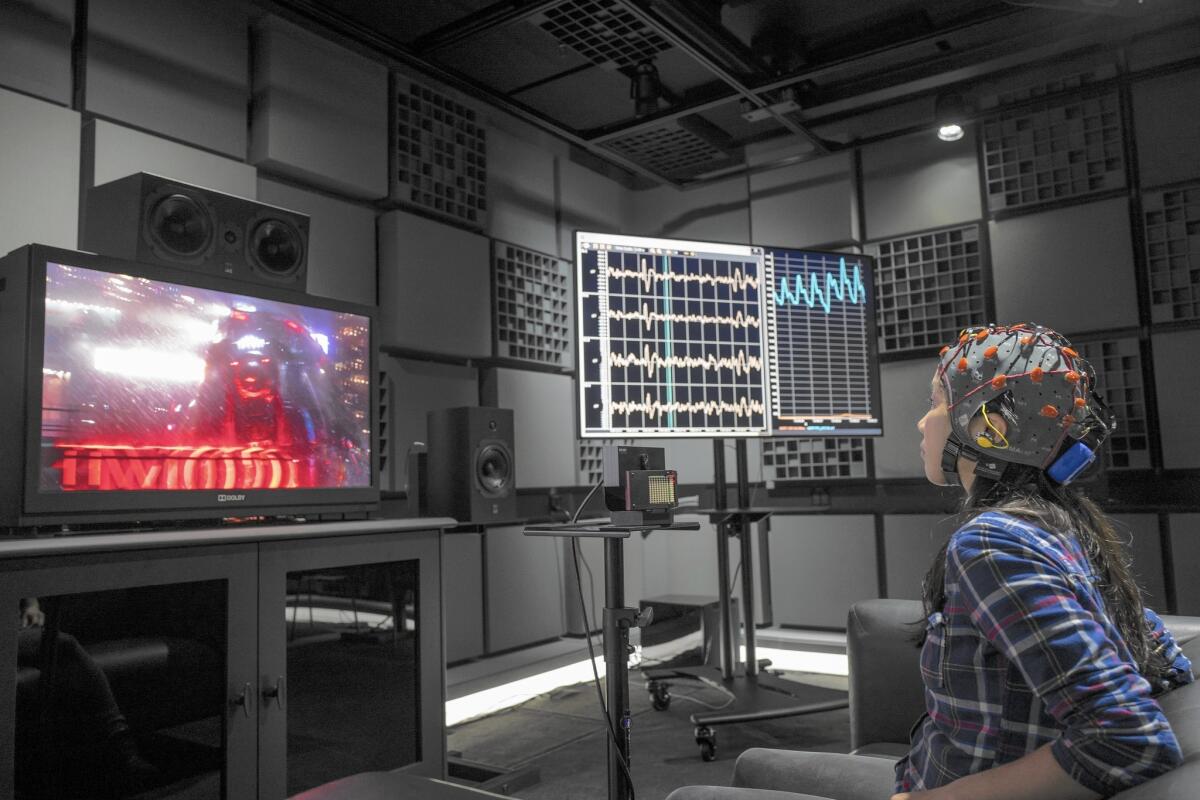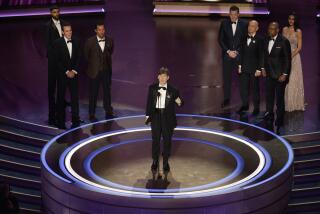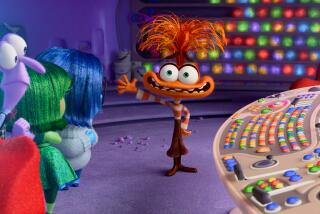Theaters are messing with your senses to make movies more real

REPORTING FROM SAN FRANCISCO — Neuroscientist Poppy Crum was watching a video of a fire dancer when she had a distinct physical sensation — the flush of her body expelling heat.
Her body reacted as if the fire was real. The experience led to a series of experiments in which Crum and her colleagues at Dolby Laboratories tested the body temperature of viewers as they reacted to the high-dynamic range image of fire.
That helped Dolby develop a laser-guided projection system that brings a higher level of realism to what moviegoers experience in theaters — making viewers, literally, feel the heat or whatever else they are watching on screen.
Laser-powered projectors. Sound that bounces around the theater. Seats that vibrate and even project mist. The century-old motion picture exhibition industry is in the midst of a technological revolution, deploying the latest in audio and visual research in a bid to attract younger audiences and stay relevant in the digital age.
“We want to create the highest, most compelling experience you can possibly have,” said Crum, head scientist at Dolby and a consulting professor at Stanford University.
The effort is reminiscent of the big push that theaters made in the 1950s and 1960s, with Cinerama and other widescreen innovations intended to compete with television’s growing popularity.
Then as now, theaters need to give people a reason to leave their fast-expanding entertainment options at home.
Today, that means not only streaming services such as Netflix, but also hugely popular video games, 4K television sets and digital sound systems that rival what consumers can get in their neighborhood cinema. The competition will only grow as virtual reality comes to the home with the release of Oculus Rift and other special devices for VR experiences that could redefine how entertainment is created and delivered.
Laser-guided projectors and other new technologies have been made possible by the industry’s conversion from film to digital formats. With financial support from the major studios, theaters over the last decade have invested $2.5 billion to convert from film to digital projectors. Virtually all of the roughly 40,000 screens in the U.S. are now fully digital.
The digital network has enabled studios to use satellites to beam movies directly into theaters, rather than shipping hard drives all over the country, thus lowering the costs of distribution and giving cinemas more flexibility to program movies when and where they want. The satellite network also gives them capabilities to stream live concerts, sporting events and other alternative entertainment to fill seats.
But theater owners are under pressure to do more to court audiences. Although box-office revenue is expected to reach a record this year in the U.S. and Canada, that’s primarily because of higher ticket prices. Admissions to theaters in North America have dropped or stagnated over much of the last decade.
The number of tickets sold in 2014 totaled 1.27 billion, down 6% from the prior year and 15% from a decade ago, according to a report from the Motion Picture Assn. of America. Admissions are expected to rebound somewhat this year.
By improving sound and projection systems, along with serving gourmet food and alcohol, theaters are attempting to differentiate themselves from other forms of entertainment.
To that end, Dolby recently introduced a new laser-projection system called Dolby Vision that produces strikingly vivid images.
Conventional digital cinema projectors don’t capture the full range of contrast between light and dark that we see in the real world. A black image on screen, for example, might actually look more like milky gray.
SIGN UP for the free California Inc. business newsletter >>
That’s one reason some directors have been frustrated with the limited capabilities of digital cinema versus old-fashioned 35-millimeter film.
Dolby’s system is intended to address that problem by creating a much higher level of luminance or contrast ratio — the range of light levels from the blackest of blacks to the whitest of whites. By creating light through lasers rather than conventional xenon lamps, the projectors also are able to create a wider spectrum of colors.
That’s especially important in a medium like animation, helping filmmakers more fully realize their artistic vision, said Jonas Rivera, a producer of Disney/Pixar’s “Inside Out,” one of several films released in Dolby Cinema this year.
The color contrast brought a high degree of realism to key scenes in the film, such as the radiating golden glow that fills the room when Riley (the main character) is born, or exploring the dark depths of her subconscious.
“We could really amplify the color space, the interior of the mind, and really take the audience where they had never been before,” Rivera said.
In addition to a sharper image quality, Dolby Cinema also includes a sound technology called Atmos that enables filmmakers to make specific sounds, such as a raindrop or a closing door, anywhere in the movie theater.
Dolby Cinema is one of the most ambitious technological innovations in the 50-year history of the company, whose audio systems are widely used in the recording industry, the home and cinemas. The company recently moved into a new 63,000-square-foot headquarters in downtown San Francisco. The complex houses more than 100 labs, including the one where Crum works.
AMC, the nation’s second-largest theater chain, plans to install the Dolby system over the next several years at as many as 100 theaters that have extra-wide screens and reclining seats that vibrate to the action on the screen. AMC charges a $5 to $6 premium above the regular ticket price for the experience
“We’re betting this is going to be the next big thing,” said John McDonald, executive vice president of U.S. operations for AMC Entertainment. “We were just bowled away when we saw the presentation on screen.”
But Dolby has competition in the gold rush for new cinematic technologies.
Belgium-based Barco has launched a panoramic projection system called
Escape, which surrounds viewers with three screens. Escape has been installed at more than a dozen theaters nationwide, including Cinemark XD at the Promenade in L.A., which showed 20 minutes of Fox’s recent “Maze Runner: The Scorch Trials” in the Escape format. The company plans to open 150 locations by next year.
“We’re trying to get the visual experience to the next level,” said Ted Schilowitz, a chief creative officer at Barco Escape and “futurist” consultant at 20th Century Fox.
Imax Corp. also has taken a leap into the cinematic future with a laser-projection system equipped with a new optical engine and other technologies that vastly improve quality and brightness.
The Canadian technology company, known for its big screens, spent three years and invested $60 million to develop the laser system, which uses Barco’s technology. Researchers in the U.S., Belgium and Canada work on the project, using patents that Imax acquired from Eastman Kodak in 2011.
The technology, which debuted in Toronto last year, was introduced this spring at the TCL Chinese Theatre during the premiere of Universal’s hit movie “Furious 7.”
“Imax has shown that people are willing to pay a premium price for a big-screen experience, and now others are following along,” said Eric Handler, a media analyst with MKM Partners.
Beyond big screens and lasers, there are the moving seats.
South Korean conglomerate CJ Group, which operates Asia’s largest theater chain, has made a splash with 4DX theaters, which offer moving and vibrating seats, along with wind, strobe, fog and scent-based effects synchronized to the action on screen.
CJ Group opened its first U.S. theater at a Regal cinema at the L.A. Live entertainment complex last year. The theater has been so popular — executives say revenue tripled after the new technology was introduced — that Regal has partnered CJ Group to open two similar theaters in New York City. CJ opened its first theater in the Midwest last month at Marcus Gurnee Mills Cinema near Chicago.
Of course, customers pay more for the experience, a premium of about $6 to $8 above the regular ticket price.
“Globally, the moviegoing audiences have long been exposed to innovation in theatrical experience — especially in Asia and Latin America, where newer theaters are being built,” said Sang Cho, chief content officer of CJ 4DPlex America. “America is catching up, with many big chains going through a renaissance of sorts with a focus on investing in new technologies and food and beverage experiences.”
Although the new technologies undoubtedly improve the quality of the cinematic experience, it remains to be seen how widespread they will become because of their high costs.
CJ 4DPlex typically invests $1.5 million to $2 million to build its facilities, depending on the size of the auditorium.
Dolby Cinema’s system (including related theater improvements) costs about $2 million, said one industry insider. A Dolby spokesman declined to discuss costs but disputed the figure, saying “implementation costs” vary depending on location. Dolby shares the costs and ticket sales with exhibitors.
Barco subsidizes its three-screen system, which costs about $100,000 to install. Theaters also pay a $10,000 fee for every movie shown in the format.
“There’s going to be more of this. The ongoing question is: Is it worth it, both to the audience and to the exhibitor?” said Patrick Corcoran, spokesman for the National Assn. of Theatre Owners.
Schilowitz of Barco and others say the industry has little choice but to innovate.
“A hundred years ago, someone hung a bedsheet and said, ‘That’s the way we’re going to watch movies.’ Essentially, it’s stayed the same way for a hundred years,” Schilowitz said.
MORE BUSINESS COVERAGE
Nearing the holidays, Little Tokyo stores get a reprieve from Metro construction
Personal Finance Q&A: Don’t ignore a deceased spouse’s credit report
Solid jobs report all but guarantees Fed rate hike; now the question is: How fast?
More to Read
Inside the business of entertainment
The Wide Shot brings you news, analysis and insights on everything from streaming wars to production — and what it all means for the future.
You may occasionally receive promotional content from the Los Angeles Times.











